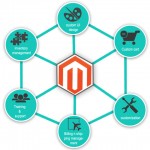In recent years, the integration of artificial intelligence (AI) into our everyday activities has increased significantly. At the heart of this advancement is the open-source movement, which encourages collaborative initiatives among developers and researchers to create groundbreaking AI projects. A growing number of developers are choosing open-source AI frameworks instead of using proprietary APIs and software.
Lets Begin With Whats Open Source
Open source software (OSS) refers to software that can be used, redistributed, and modified at no cost, often made accessible through public code repository services. The advantage of open source is that they are a clear and collaborative process that benefits from community-driven peer evaluation. Open source projects can be rapidly updated and adapted as required, providing dependable and versatile software that isn’t constrained by proprietary systems. These projects, available on platforms like GitHub, play a pivotal role in digital innovation across sectors such as healthcare, finance, and education.
Let’s Have A Look At The Benefits Of Using Open Source AI
Open-source AI has become a significant contributor to fostering innovation and accessibility in numerous domains. Its distinct features provide substantial advantages for developers, researchers, and organizations. Here are a few key benefits:
- Transparency and Continuous Enhancement:
The inherently collaborative nature of open-source AI ensures transparency and continuous optimization, culminating in the evolution of robust, feature-rich, and modular AI toolsets. - Plethora of Use Cases:
Open-source AI platforms encompass a multitude of advanced applications, including but not limited to, real-time anomaly detection, medical imaging diagnostics, personalized recommendation engines, and adaptive learning systems. - Accessibility:
Open-source AI frameworks and models are readily available to developers, researchers, and enterprises, promoting extensive adoption and operationalization. - Engaging Community:
Leveraging open-source AI empowers organizations to tap into a vibrant ecosystem of contributors who perpetually enhance and advance AI methodologies and frameworks. - No Vendor Lock-in:
Open-source AI paradigms ensure organizational autonomy by preventing vendor lock-in, thus affording organizations greater flexibility and independence in their technological pursuits. - Cost-Effective:
Open-source software is often available at no cost, reducing the overall expenses for businesses and individuals. - Flexibility and Customization:
Users have the freedom to modify and tailor the software to meet their specific needs, ensuring it fits perfectly into their workflows. - Interoperability:
Open-source solutions often adhere to open standards, ensuring better compatibility and integration with other systems and technologies. - Rapid Development:
With contributions from a global community, open-source projects can evolve and improve more quickly than proprietary software, keeping pace with technological advancements.
Top 5 Open Source AI Platforms
1. Tensor Flow
TensorFlow is an open-source platform developed by Google, designed for machine learning and deep learning applications. It provides a comprehensive ecosystem of tools, libraries, and community resources that facilitate the building, training, and deployment of machine learning models across various devices and platforms. TensorFlow supports a range of functionalities, from basic machine learning algorithms to state-of-the-art deep learning models, making it a versatile choice for researchers, developers, and enterprises. Its flexibility, scalability, and extensive community support make it one of the leading frameworks for innovative AI solutions.
| Key Focus Areas | Strengths | Weaknesses |
|
|
|
2. PyTorch
PyTorch is a machine learning library that is open-source and developed by Facebook’s AI Research lab. Its flexibility and user-friendliness make it particularly popular among researchers who engage in experimentation and prototyping. The library utilizes a dynamic computation graph, enabling a more intuitive and adaptable approach to model creation compared to frameworks that use static graphs. PyTorch is versatile, supporting various applications ranging from computer vision to natural language processing, and it offers excellent GPU acceleration. With a large community and strong backing for deep learning, it has become a preferred option for both academic research and production-oriented AI development. The combination of PyTorch’s adaptability and dynamic features plays a significant role in its widespread appeal within the AI community.
| Key Focus Areas | Strengths | Weaknesses |
|
|
|
3. Rasa
Rasa is an open-source framework designed for building AI-powered conversational agents and chatbots. It provides a suite of tools for natural language understanding (NLU) and dialogue management, enabling developers to create highly customizable and flexible conversational AI applications. Rasa allows for easy integration with various messaging platforms and services, making it suitable for a wide range of use cases, from customer support to interactive user interfaces. Its strong focus on machine learning and real-time interaction ensures that chatbots built with Rasa can handle complex dialogues and provide personalized responses. With an active community and extensive documentation, Rasa is a go-to solution for developers looking to create sophisticated conversational AI systems.
| Key Focus Areas | Strengths | Weaknesses |
|
|
|
4. Keras
Keras is an open-source neural network library written in Python, designed to enable fast experimentation with deep learning models. It acts as an interface for the TensorFlow library, providing a high-level API that simplifies the process of building and training neural networks. Keras is known for its user-friendly, modular, and extensible design, which allows developers to quickly prototype and experiment with various neural network architectures. Its seamless integration with TensorFlow and other backends makes it a versatile tool for deep learning practitioners. Keras is widely used in both research and industry, thanks to its ease of use and powerful capabilities.
| Key Focus Areas | Strengths | Weaknesses |
|
|
|
5. Amazon SageMaker
Amazon SageMaker is a fully managed service provided by AWS that simplifies the process of building, training, and deploying machine learning models. It offers a comprehensive set of tools for data scientists and developers, including integrated development environments (IDEs), distributed training, and model deployment capabilities. SageMaker supports a wide range of machine learning frameworks and provides a unified studio for data processing, model development, and analytics. Its scalable infrastructure ensures high performance and cost-effectiveness, making it suitable for both small projects and large-scale enterprise applications.
| Key Focus Areas | Strengths | Weaknesses |
|
|
|
Accelerate Your AI Projects With AI
Challenges While Using Open Source AI
As the adoption of open-source AI continues to grow, it brings a host of benefits, like cost savings, flexibility, and community-driven innovation. However, leveraging open-source AI also presents unique challenges that developers, researchers, and organizations must navigate. From ensuring the quality and security of contributions to addressing compatibility and intellectual property concerns, the open-source landscape demands a careful and strategic approach. In this section, we will explore the various hurdles associated with using open-source AI:
- Transparency and Explainability:
Although open-source AI fosters transparency, achieving true explainability and comprehensibility for non-experts continues to be a hurdle. - Security Risks:
Open-source AI initiatives may face security threats such as code injection, data breaches, and other malicious actions because they are accessible to the public. - Quality Control:
Maintaining consistent quality across different contributions can be challenging, as open-source projects depend on community input, which can vary in terms of quality and reliability. - Compatibility Issues:
Merging open-source AI tools with current systems can occasionally result in compatibility problems, necessitating extra effort to remedy.
The landscape of open-source AI platforms is rich with opportunities for innovation and advancement in artificial intelligence. Platforms like TensorFlow, PyTorch, Rasa, Keras, and others have proven to be invaluable tools for developers, researchers, and organizations alike, offering robust frameworks for a wide array of AI applications. These platforms not only provide the flexibility and scalability needed for cutting-edge projects but also foster a collaborative environment that drives continuous improvement and innovation. By leveraging the strengths of open-source AI, we can push the boundaries of what’s possible and create intelligent solutions that benefit society as a whole.










